Wildflower families: Fabaceae, the Pea family
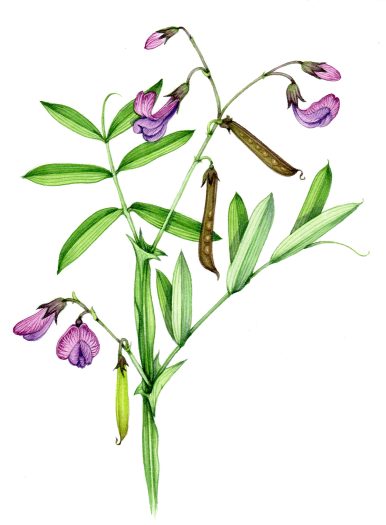
Wildflower families: Fabaceae, the Pea family is my latest blog in this series on common flower families. I was inspired to blog about common families of UK wildflowers by my online Field Studies Council course. I spend a lot of time looking at and drawing wildflowers, so it’s a treat to learn more about family similarities and differences.
For terminology, look at my the basics of botany blog, and on fruit types. What’s in a name 1 and part 2 discuss how Latin names work and why they matter. Some of the other families I’ve examined include the Ranunulaceae (Buttercups), Caryophyllaceae (Campions), Rosaceae (Roses), and Brassicaceae (Cabbages). I hope to add more over the coming months.
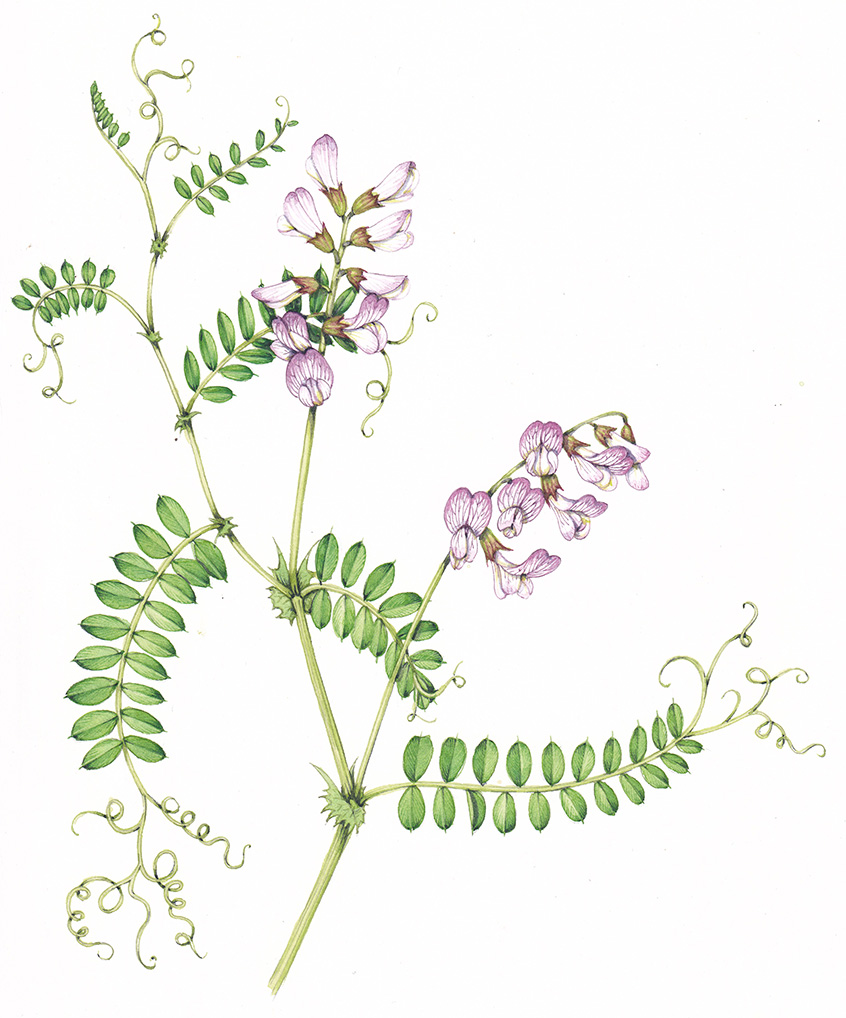
Wood vetch Vicia sylvatica
I know a bit about wildflowers, but I am not a trained botanist. So if you see a mistake, please let me know, thanks.
Wildflower families: Fabaceae
The Pea family has 640+ genus and a whopping 18,000 species and is the second largest family of flowering plants. They grow across most of the globe and include many crop plants.
Leaves have stipules, and tend to be made of three leaflets (trifoliate) or many paired leaflets. They also have tendrils. Fabaceae play a vital role by fixing free nitrogen in their roots, which helps soil health. Fruits in the Fabaceae are variable, although most grow in pods which split down both sides at maturity.
As well as Sweet peas and Broom, other Fabaceae garden flowers include Lupins, Wisteria, and Laburnum. (For a step by step blog on painting a sketchbook study of a Lupin, click here).Crop plants in the pea family include lentils, peas, beans, alfalfa, tamarind and the nitrogen fixing clover. There are many wild flowers are in this family, including vetches, gorse, and the excellent Bird’s foot trefoil.

Bird’s-foot Trefoil Lotus corniculatus
Fabaceae overview
Plants in this family have trifoliate alternate leaves with stipules at their base, twining tendrils, and nitrogen fixing roots. The stipules are often large. The flowers have five petals of different shapes, and only one line of symmetry, and the fruit grow in pods. The name Fabaceae comes from the Latin for bean, Faba.
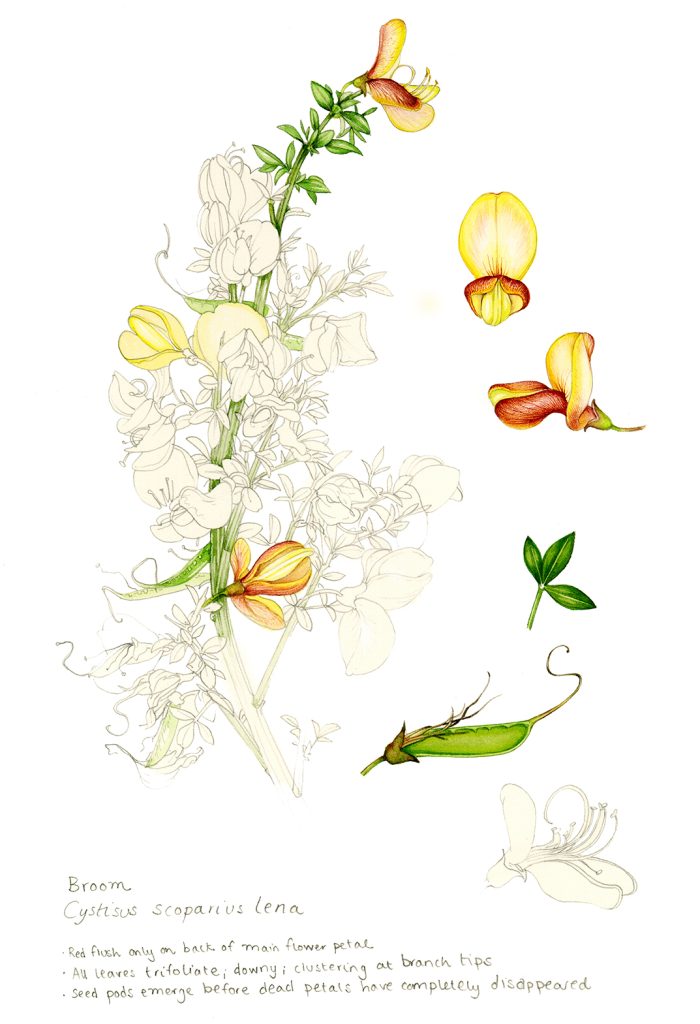
Broom Cystisus scoparius lena sketchbook study
Fabaceae Leaves
Fabaceae leaves are compound, many consisting of three leaflets. A good example is the Red clover. (For more on compound vs simple leaves, look at my blog). Lots of Fabaceae have pinnate leaves, (a leaf made of multiple pairs of leaflets). Vetches have pinnate leaves. Leaf margins tend to be smooth.
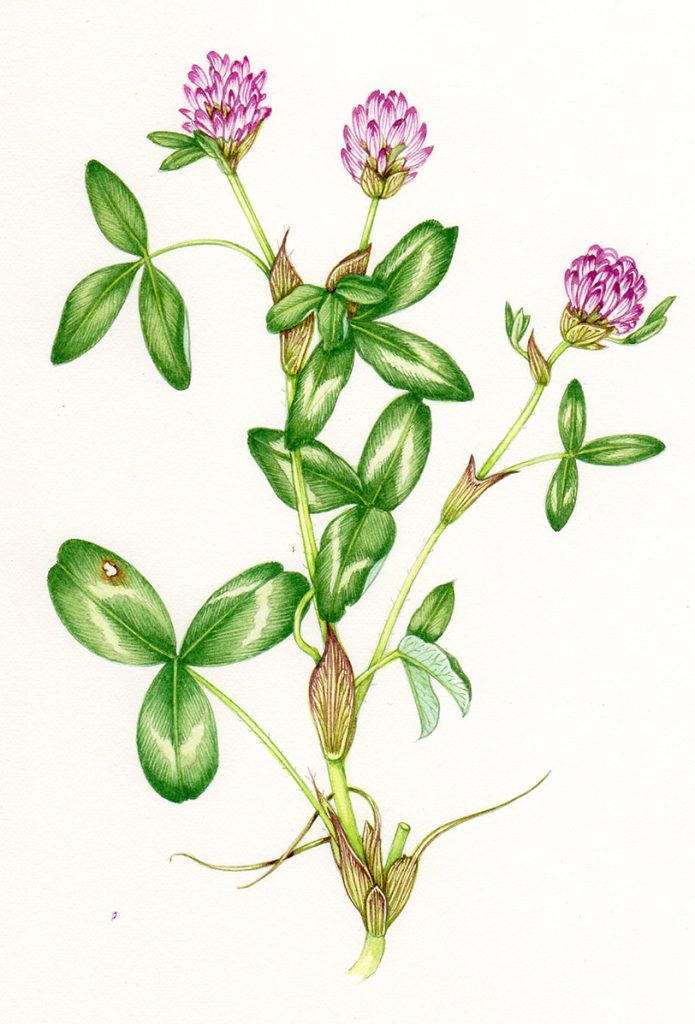
Red clover Trifolium pratense. A step by step blog on illustrating clover can be found here
There is a lot of variety in Fabaceae leaves. Gorse has reduced its’ leaves to furrowed spines, and leaflets can be elongate, lanceolate, or almost round. (I did a blog on leaf shape, if it appeals.)
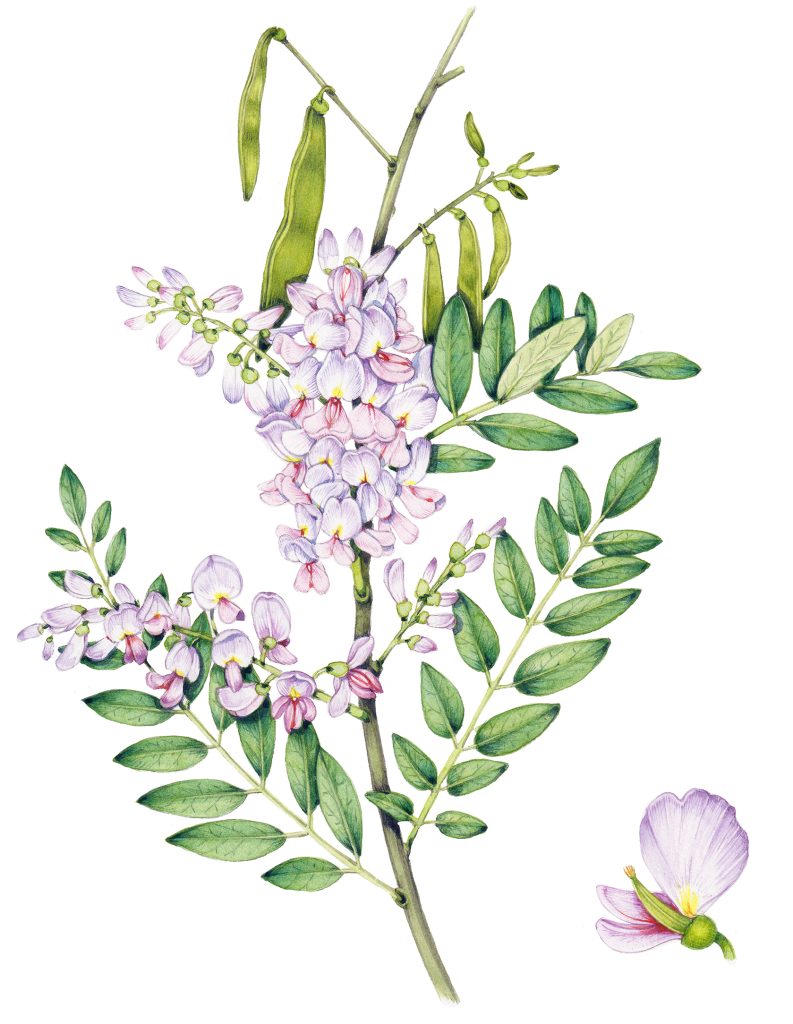
Bush tea Gliricidia sepium
Stipules grow in pairs at the base of a leaf, and vary in size. The garden pea has obvious rounded stipules, whilst those of the vetches are far smaller. In some cases, like the Acacia, these stipules have evolved into spines.
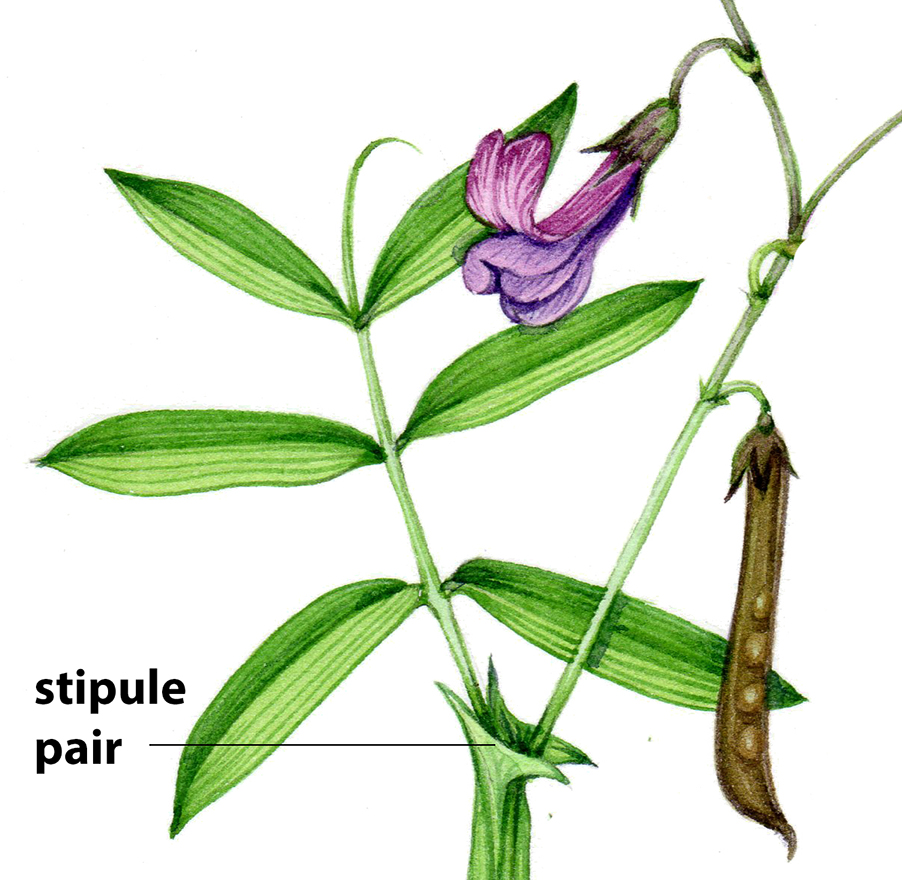
Bitter vetch Lathyrus linifolius showing paired stipules

Garden pea Pisum sativa stipule
Lots of plants in the Pea family have thread-like tendrils which help the plant climb and grow by twining around supports or other plants. These may be single or split into several smaller branches. These splits can be useful in telling differences between species. Tendrils can grow from leaves, or from the stem of a plant.
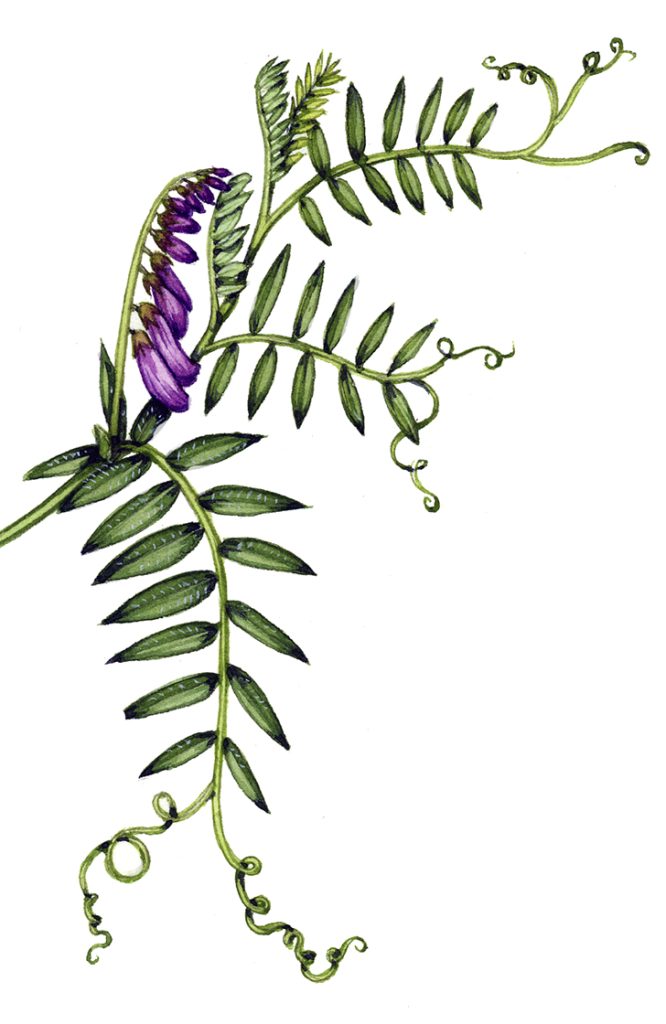
Tufted or Bird vetch Vicia cracca tendrils
Fabaceae Roots
Roots of Fabaceae often have nodules, or tubercules. These can be seen with the naked eye.
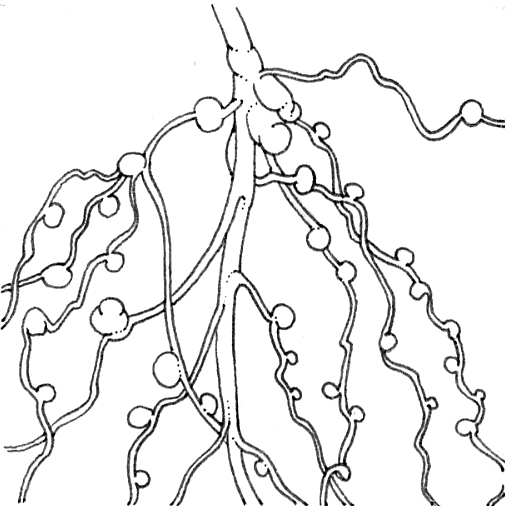
Clover root nodules
Tubercules are part of the root, and house communities of Rhizobia, symbiotic bacteria. The bacteria can fix free atmospheric nitrogen into ammonium, which the plant uses. When a Fabaceae dies, all the ammonium rots down to nourish the soil, along with other plants growing there.

Nootka lupin Lupinus nootkatensis roots
This explains why cover crops are used in agriculture, and how many green manure crops work.
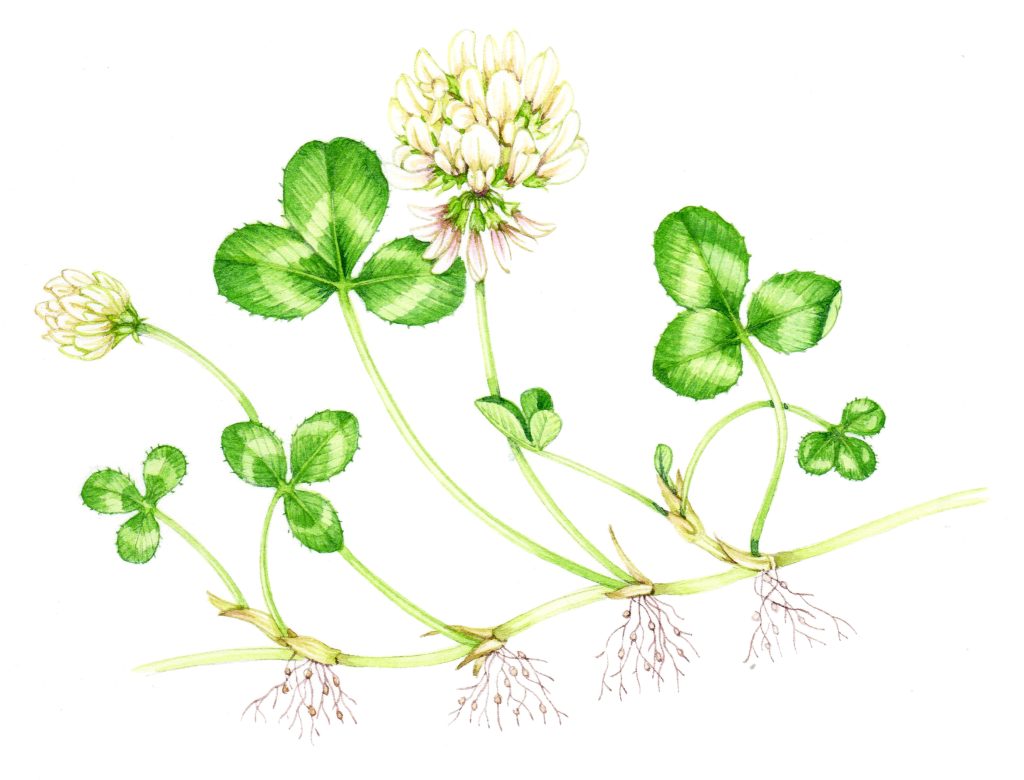
White clover Trifolium repens with roots and nodules
Fabaceae Flowers
Pea family flowers are usually bisexual and made of five petals which grow in a distinctive shape. The standard is the top petal, standing erect. Below this are a pair of lateral petals, the wings. The lowest petals are fused and act like a landing pad for visiting pollinators and is called the keel.
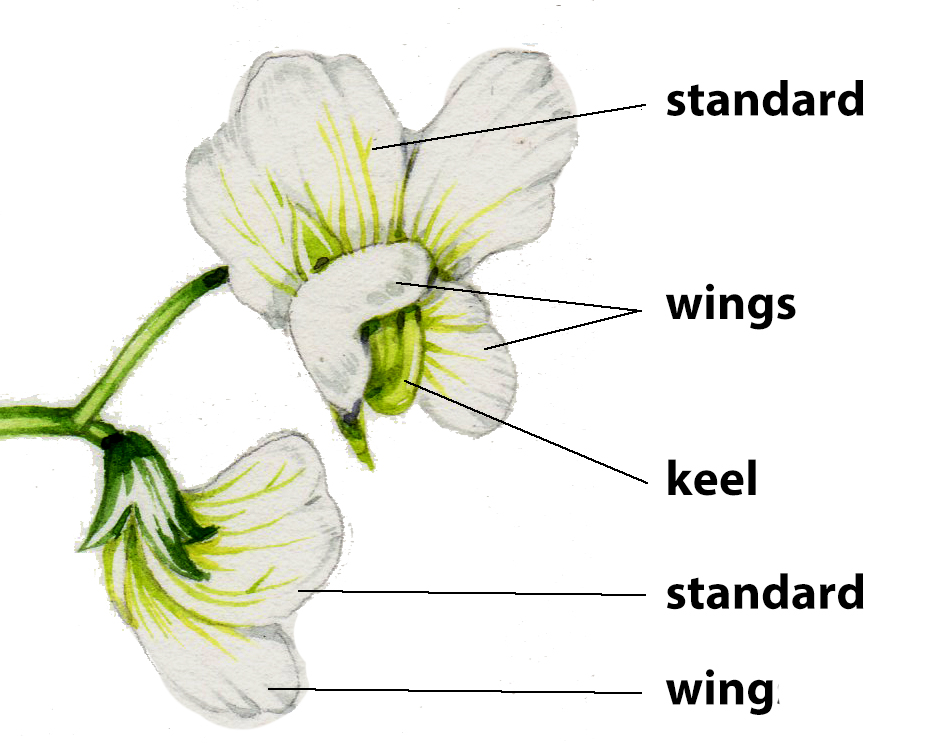
Common pea Pisum sativum flower showing typical Fabaceae flower structure
Flowers are often borne in densely packed clusters, known as racemes.

Crimson clover Trifolium incarnatum flowering head
You can see this in the clovers and plants such as the Kidney Vetch Anthyllis vulneraria.
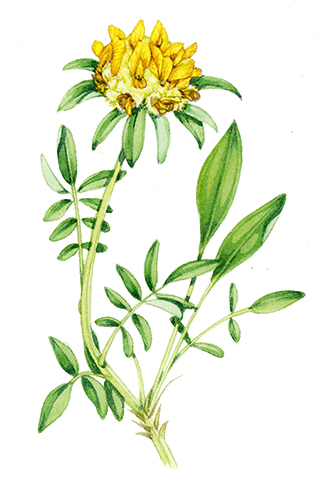
Kidney Vetch Anthyllis vulneraria
However, they can also be borne singly, or in pairs. The Broad-leaved everlasting-pea Lathyrus latifolius is an example with a few-flowered raceme. For a step by step guide on illustrating this plant, look at my blog.
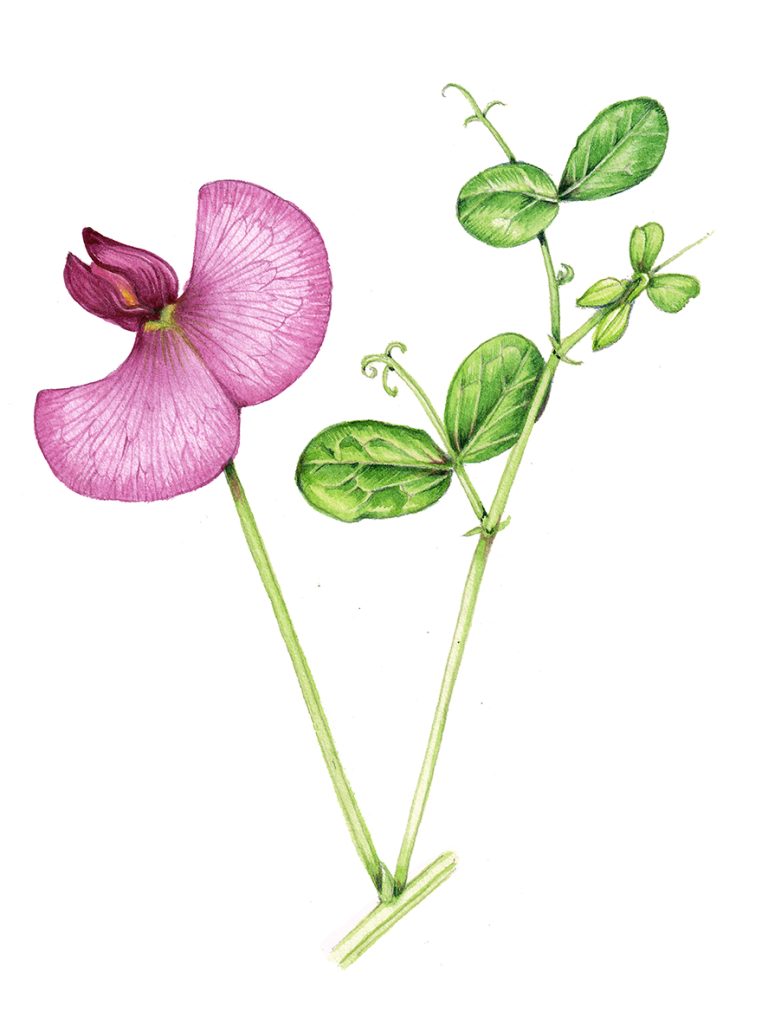
Broad-leaved everlasting-pea Lathyrus latifolius
The sepals are fused into one calyx tube and there are either 10 fused stamens, or 9 which are fused and one which is free. These are mostly tucked away inside the corolla tube, so you may need to dissect the flower to see them.

Blue bonnet Lupin Lupinus polyphyllus cross section
There is one or occasionally two carpels (the female reproductive organ of a flower, consisting of a style, an ovary, and a stigma) which is superior, growing above the flowering structure. For more on ovary positions look at my blog on the ovary.
Fabaceae Fruit
Pea family mostly bear their fruit in pods. The pod itself is known as a legume, and splits down both sides (sutures) at maturity. There are many different shapes of legume pod. Some have wings, or are flattened like the Judas tree Cercis siliquastrum.
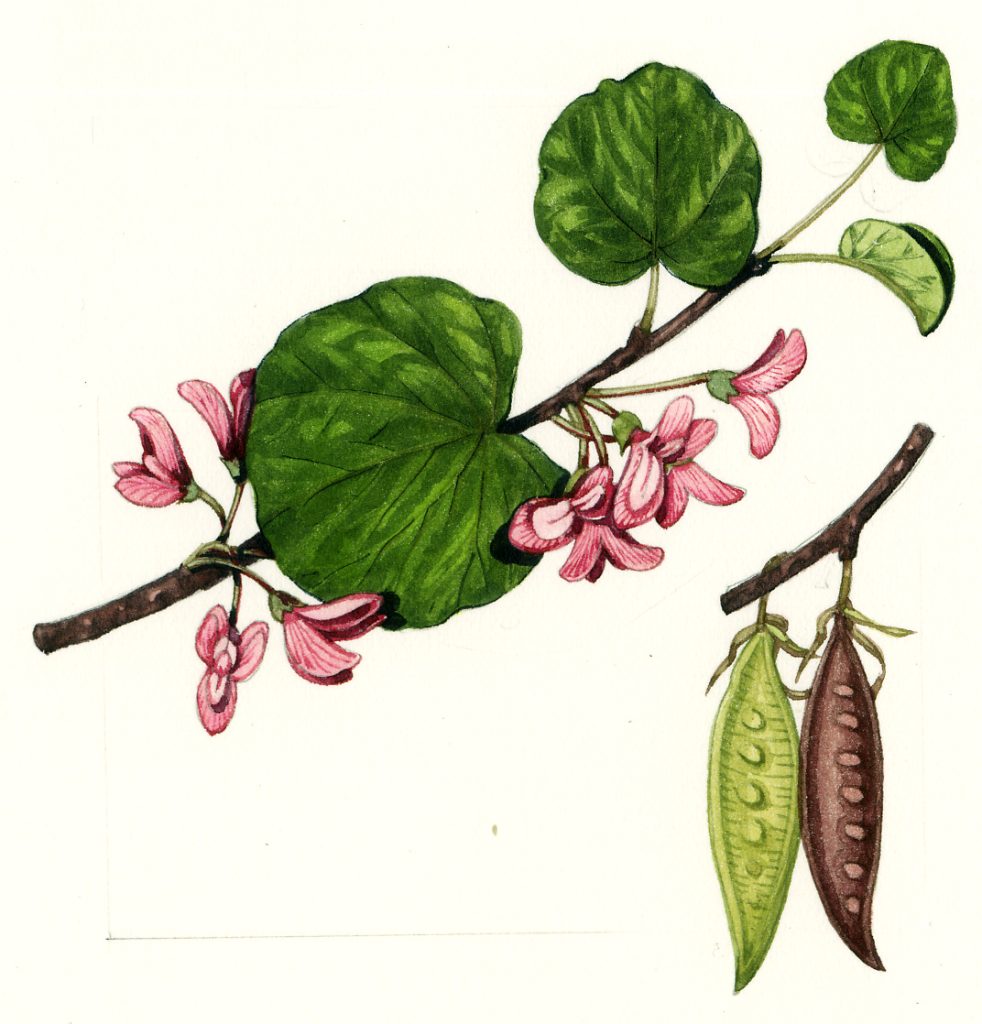
Judas tree Cercis siliquastrum pod
Some have constrictions between the seeds, like the Bird’s-foot species.
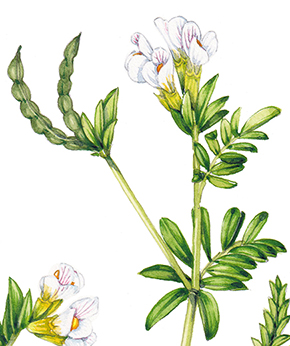
Little White Bird’s-foot Ornithopus perpusillus
Other split open at maturity, using this mechanical force to spread the seeds. You can hear this as distinctive “pops” on a hot day in late summer, among gorse plants.
The pods may be clustered together, as with lupins, or single, like the garden pea and broad bean. Pods can be smooth or furry.
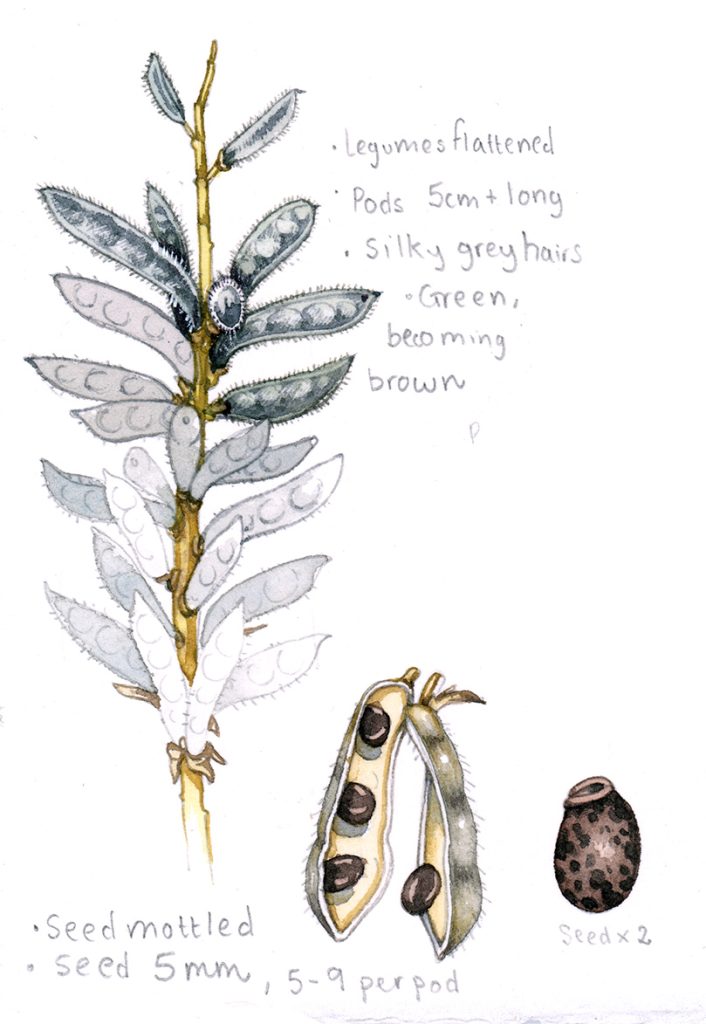
Blue bonnet Lupin Lupinus polyphyllus seed pods
They may remain green until mature or turn brown or black. Our garden peas are harvested before the peas are fully ripe, but even if left to grow the pea pod remains greenish.
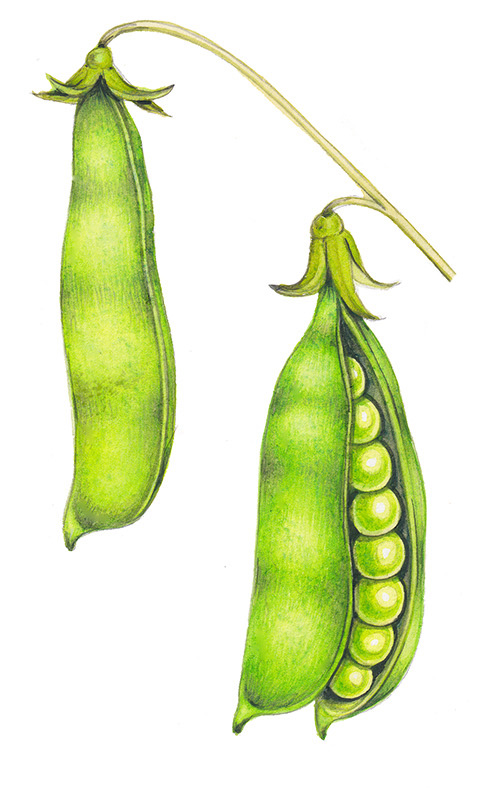
Garden Pea Pisum sativum pod
Some species have clusters of small pods, each containing one or two seeds. Black medick has lots of little pods held together which go shiny black at maturity.
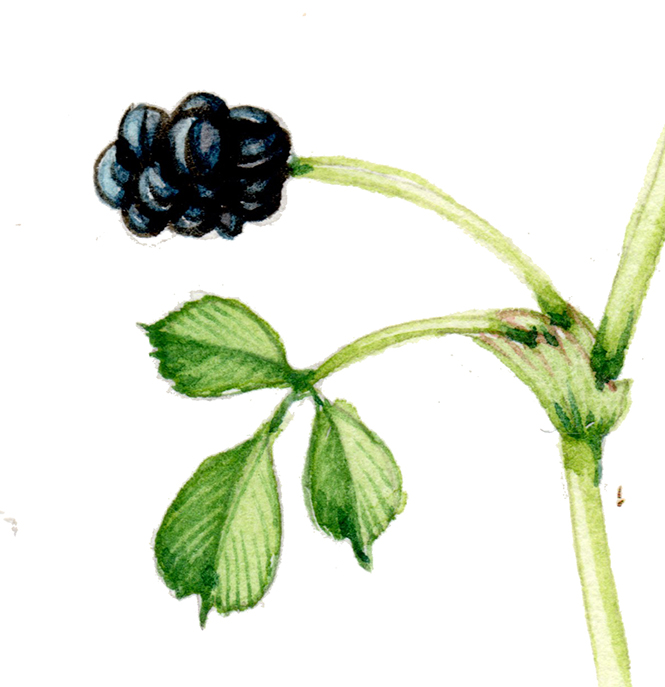
Black medick Medicago lupulina pod
One of the most surprising is the spirally coiled seed pod of the Alfalfa (or Lucerne) Medicago sativa. These pods contain 10 to 20 seeds.
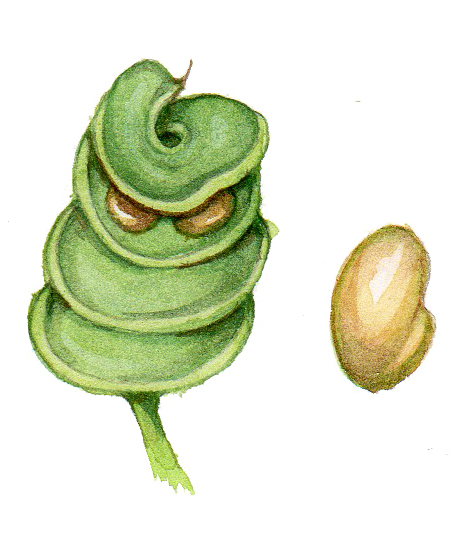
Alfalfa (or Lucerne) Medicago sativa pod
Fabaceaee: Other species
This blog has already covered loads of the Fabaceae species; both those that are economically important, and those that we use in our gardens.
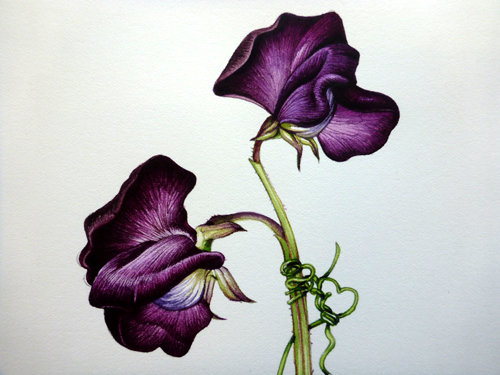
Sweet pea (for a step by step blog on illustrating this click here)
From beans to alfalfa, laburnum to wisteria, peas to vetches, gorse to chickpeas, fenugreek to restharrow…. Fabaceae are a widely varied family, but thanks to the splitting pods and distinctive flower shape, they are comparatively easy to recognize.
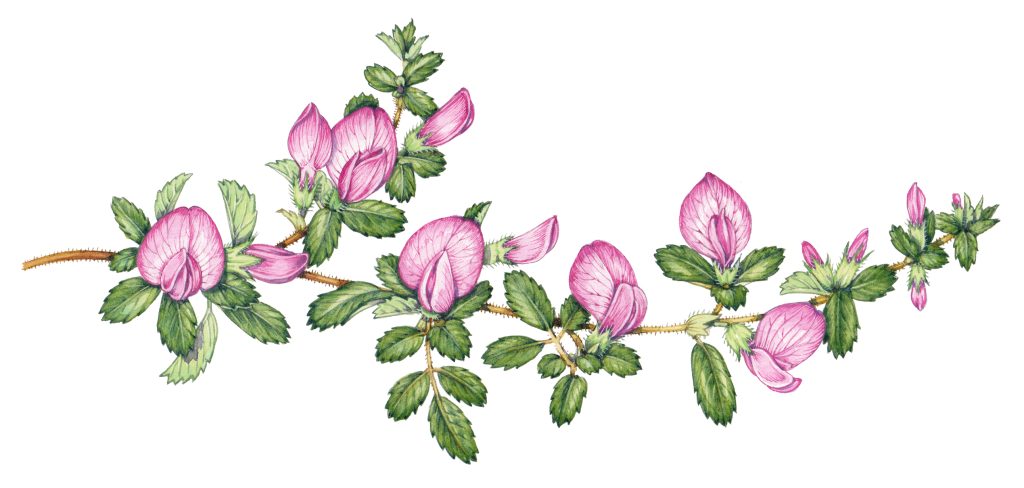
Restharrow Ononis repens
Conclusion
I hope this Fabaceae wildflower family blog was useful. Click here to access my blogs on other common wildflower families. I’ll be doing even more of these blogs over the coming months. My references included my FSC botany course, the Common Families of Flowering Plants by Michael Hickey & Clive King, and the excellent Naturespot website.
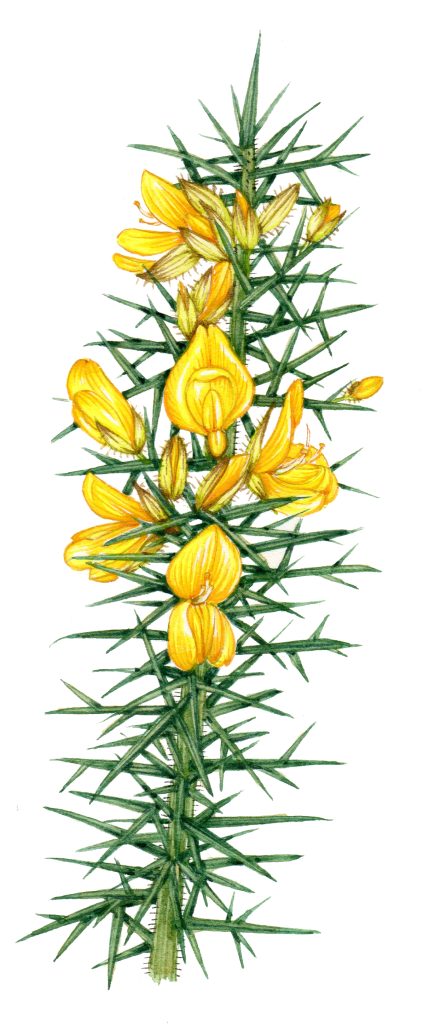
Gorse Ulex europaeus

